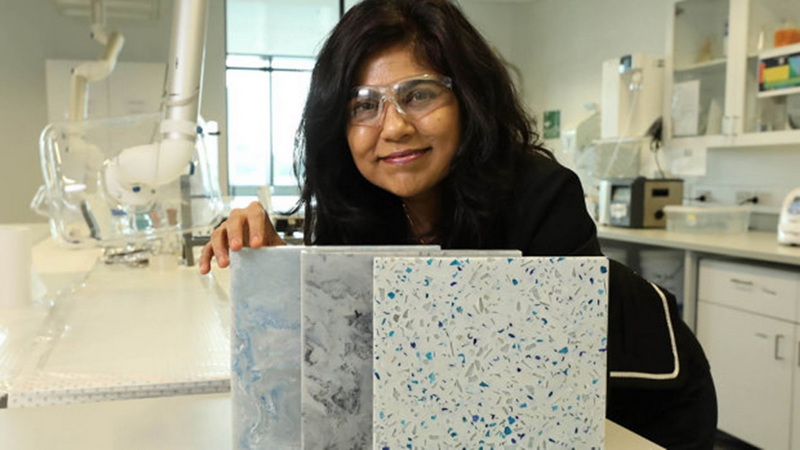Resource Circulation: The Evolution of Unwanted Clothes
By Chung Hyun-hwa
Joseph Had a Little Overcoat, by Eric Carl, is a story about a man who changed his worn overcoat to a jacket, a vest, a scarf, a tie, and a button at the end, instead of throwing it away. When I was little, people would repair clothes, knit from old sweaters, and fix holes in socks. Those times are quite over.
I watched a shocking documentary about clothing waste. According to statistics, over 180 billion pieces of clothing are consumed every year steadily, except for 2020 and 2021 because of Covid-19, which is over 22 pieces per person on Earth. Out of this, 33 billion pieces, or four pieces per person – babies included – become waste, and quite a large amount of clothes out of these 33 billion pieces are thrown away unused because they were either unsold or just bought and never worn. The apparel market is set to grow in the following years despite this situation. The documentary pointed out that SNSs were playing a part in this because clothes were bought only for one or two pictures for SNS postings. This is only possible because of the fast fashion industry that supplies clothing items at such low prices.

So what? We have clothing collection boxes standing on corners of our neighborhoods. Who put the boxes there? Yes, in Korea, local district governments have the authority to put them there, and their contractor companies actually do the collection and use them to make a profit from the donations. This allows the districts to take care of clothing waste, and the contractors make profits. About 40 percent are selected first for domestic secondhand shops, and the rest of these worn or unworn clothes are compressed and exported to other countries mostly in Africa. In markets such as those in Ghana or Kenya, about 40 percent of the imported secondhand clothes are sold, and the rest are burnt or just thrown away anywhere, much to our surprise. The clothes create mountains on land or drift into rivers, creating serious pollution there. These countries are not able to handle such great amounts of clothing waste, and learning this made me feel terrible.
I stopped buying new clothes three years ago to reduce plastic usage since most clothes contain PE plastic, and there were other environmental issues shaping my decision, too, including water consumption. (One T-shirt uses 2,700 liters of water to produce.) I decided to minimize buying new clothes and live on what I already had. This was not difficult – in fact, it was easy. It saved me time and money, and clothing repair became one of my new projects. The old clothes became material, not waste. Fixing clothes or upcycling is good at the personal level, but thinking of the massive amount of abandoned clothes outside, I wondered if there were any solutions. I searched for what other people who care about this situation do to help with utilizing fabric waste resources.
Some companies with more sense of responsibility started using unsold clothes they would have discarded before to create new clothes. This was a bigger version of my repair project. Some other companies shred their clothing waste to make cheap, unwoven fabric that can be used for agriculture or construction. There are trials to produce rewoven fabric out of fabric waste, but I do not think this is very effective because it involves chemical processes or too much energy consumption.

The most innovative upcycling idea I found so far is creating products for architectural purposes. The first company that got my attention is run by Dr. Sahajwalla in Australia and makes ceramic tiles out of fabric waste. Another is a Swedish company named BAUX, which is producing acoustic insulation out of fabric waste. After finding these, I wondered if I could find such products in Korea. Whoa! I found one company that sounded amazing: Sejin Plus. This company produces beautiful panels from fabric waste. There is a sample house in Chungbuk Province entirely built with the company’s “Plusnel” products. What is more astonishing is that these products are manufactured by workers who have disabilities. This is because Mr. Park Jun-yeong, the CEO, is a parent of a child with a disability. He was awarded as the 2021 Contributor to Korean Society. I really think he is the biggest winner.
I tried searching for businesses like this in Gwangju. I even called City Hall, but sadly there are no recycling businesses that use fabric waste as material yet. I asked if there were any subsidies to encourage these upcycling startups or businesses, but at the moment there are none, and the public officer on the phone said that the rigidness of the system, the laws, and the policies are the obstacles to the innovation to convert waste into new resources.
So, what can we do? Having a personal goal of reducing clothing waste by consuming just enough is great. Exchanging clothes or buying secondhand clothes when necessary is good for not stimulating more apparel production. (This is good for your wallet as well.) Also, we have to raise our voices so that governments will try to have more constructive solutions rather than hiring companies to find a landfill in other countries unethically. We should try to take care of our own waste instead of passing it on to someone else’s yard. If it can create jobs, too, it will be super.
Some say without consumption, there is no economy. I am not saying we should not consume, but we should not overconsume so we can have a future. I miss the time when we could see the Milky Way and the floating fireflies on summer nights without worrying about the rising sea level. I wonder what Joseph would think of seeing the mountains of discarded clothes in Africa.
(If you would like to read more about the companies and their products in this article, please refer to the links under the pictures)
The Author
Chung Hyun-hwa is from Gwangju and is currently leading Gwangju Hikers, an international eco-hike group at the GIC, and teaching the Korean language. Previously, she taught English in different settings, including Yantai American School and Yantai Korean School in China, and has worked for the Jeju school administration at Branksome Hall Asia in recent years. She holds a master’s degree in TESOL from TCNJ in the U.S.



